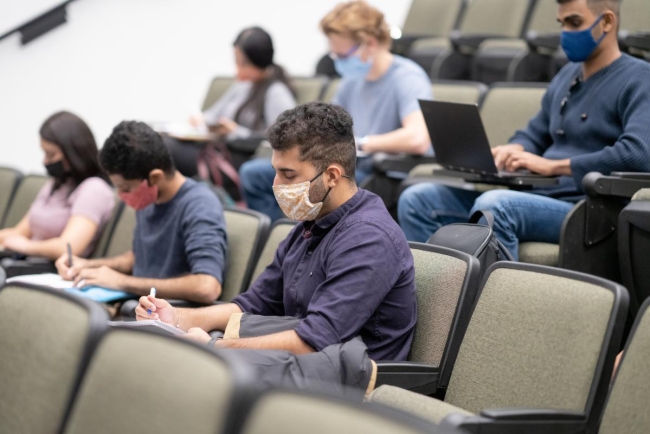You have /5 articles left.
Sign up for a free account or log in.

FatCamera/E+/Getty Images
The COVID-19 pandemic has forced monumental and continually shifting changes to the way we teach college students. As the spring 2022 semester has rolled along amid pressure from virus variants, part of me is still processing the fall 2021 semester.
It was a semester in which the private four-year college where I teach economics courses faced the challenge of turning the tide of instruction modality from COVID-imposed online to in person. It was a transitional time, with most students returning to residential living, while a very few were not. In-person learning was no longer a modality deemed too risky but was practically a requirement, as in pre-COVID semesters. A rigorous approval process was in force for those students seeking remote learning, with many being flatly denied and forced to withdraw for the semester. Only a very few were approved for remote learning. The COVID-era of accommodating students in their many varied situations had ended as of fall 2021.
As an instructor, part of my understanding for this hard-line approach is to prevent disgruntled parents from complaining that they are paying for room and board while their students are not attending class and, in the worst case, commencing lawsuits over tuition charged for online classes. As we all know, this has been a thorn in the side of many residential colleges during the pandemic. In response, the college where I teach opened for hybrid classes in spring 2021, accommodating both in-person and remote students according to the student’s own choice. Any student who could make it to campus would take in-person classes, while any student who could not would be accommodated with remote learning.
The implicit assumption underlying these hybrid courses was that any student living on campus would fully engage with in-person learning. However, my own experience in the classroom is that students definitely do not equate on-campus with in-person learning. All residential students do not necessarily show up to their in-person classes. Given the opportunity, many stay in their dorm rooms and opt for virtual classes. Other faculty at the college where I teach have experienced the same phenomenon.
Fear of COVID exposure could be a reason, but I believe the main reason is simply being accustomed to the convenience of online learning. Thus, a new breed of student was created—the residential-remote student. Not surprisingly, parents objected to costly room and board charges for their students who do not attend in-person class. So for fall 2021, faculty were advised that all students would be expected to attend in-person classes, and hybrid classes would be a thing of the past.
The college where I teach offers only one allowance for online instruction at the college, and that is for courses enrolling more than 120—the maximum allowed number of students in a physical space. Only those courses would be divided into groups of fewer than 120; each group attends in-person class on alternate days and joins the live broadcast on off-alternate days. That way, each student has the opportunity to attend class in person part of the time. Still, we are to expect students to attend, whether their turn is in person or via live broadcast.
This is where I find myself as an instructor of economics courses that enroll far in excess of the 120 limit. Simple enough, I thought as I planned my courses in August 2021. I welcomed a return to the classroom after two entire semesters of online-only teaching. Once I figured out the hardware and software needed to conduct a live broadcast, this should work fine, I thought. I only grappled with one thing, the attendance expectation—that all students are expected to attend class. How would this work in my large lecture classes enrolling up to 300 students, even with the smaller groups of fewer than 120?
It was not my practice to require attendance, since I have never been inclined to micromanage my hundreds of students. It would take extensive TA resources to monitor and grade attendance, complete with a late policy—resources I did not have. Furthermore, attendance in my large lecture classes drops significantly after the first three weeks of the semester, as the class quickly settles into two groups: attendees and nonattendees, or basically, those who value the traditional in-person experience and those who do not.
This is a trend I have been observing for years. Other faculty I know have experienced the same, so much so that some use two different grading tracks: one for students who wish to attend class and another for those who wish to opt out. In fact, based on my attendance counts pre-COVID, by the eighth week of the semester, the majority of students usually stop attending. Those students clearly display a preference to learn independently with a good textbook and Blackboard resources, while saving themselves time spent in class. Add to that courses effectively COVID-modified to facilitate remote learning, and it is very convenient for students to not attend class.
So I doubted students would respond positively to the college’s attendance expectation, but I thought perhaps students would have a new appreciation for in-person learning after the COVID experience. Perhaps I would see more students in the classroom than ever before. Perhaps this would be a semester unlike any other. I was open to the possibility that the trend of declining attendance would turn around in the wake of the crisis we had all just endured.
I decided that my simple strategy would be to state in the syllabus that attendance was expected and no student would be supported in remote learning without the official approval of the college. If student sentiment had indeed changed, then that statement alone should be enough to pull students into the classroom and keep them there for the duration of the semester. I then embarked upon my semester of hybrid courses, curious as to how this would play out.
Embracing the New Resident-Remote Student
Now, with fall 2021 behind me, I can report on my experience. The first day of class saw total attendance, in person and live broadcast together, at 95 percent of total enrollment. As I suspected, some students did not get the memo regarding the divided group assignments for alternating in person and live broadcast; the number of students in the classroom on that first day exceeded the 120 maximum allowed. Oops. One class exceeded it by a long margin, with 155 students present in the classroom. Fortunately, no COVID outbreak resulted.
What unfolded next over the first weeks of class was my main interest. Would students attend class according to the attendance expectation, or would they follow the customary trend with many choosing nonattendance? What I observed is that total attendance fell consistently throughout the first half of the semester. Each of my course sessions saw a decline in attendance from the first-day high of 95 percent to only 20 percent during the week before Thanksgiving. The greatest marginal fall from one class to the next occurred during the fourth and fifth weeks of this 15-week semester. Of those attending class, most joined via the online broadcast instead of in person, even though the classroom had plenty of socially distanced seats.
The college wants students physically present in the classroom. However, I see students expressing a different preference for the courses I teach. Our expectations for attendance seem to have diverged from the preferences of students enrolled in my high-enrollment courses. We should not believe that on-campus living implicitly begets in-person learning. In my experience, students are holding fast to COVID-style remote learning in the residential setting.
I am not the only instructor who has experienced this phenomenon, as colleagues of mine here and elsewhere have shared tales of empty classrooms and lesson plans altered to accommodate few in-person students. Will four-year residential colleges formally embrace the residential-remote student and give them the online options they want, particularly with regard to the high-enrollment courses? Or will they push for a return to pre-COVID normalcy and expect attendance, even in the large courses?
My opinion on the matter is pragmatic. Given that I have developed such comprehensive resources to make a successful online course, I believe that students who wish to enroll as a purely online student should be allowed to freely do so. At the same time, students who value the traditional in-person experience should have this opportunity. But I am not keen on combining the two modalities in one hybrid course—it spreads thin my attention to students and requires of me a level of multitasking that is inefficient. I can deliver a very good course, either online or in person, but not merged together.
Additionally, the teaching load should reflect that this type of hybrid course counts as two courses for faculty members. I never liked the “teach two courses, get paid for one” deal that is inherent to the hybrid style. My recommendation is that colleges separate their online courses from in-person courses, allow students to choose and organize faculty workload accordingly. In the end, quality of instruction will rise, pandemic or no pandemic.
My expectations for the current spring 2022 semester are realistic—I do not expect the majority of my students to attend class. However, this time I will discontinue the live broadcast as soon as the total of in-person and live broadcast attendees is fewer than or equal to 120, the maximum room occupancy allowed. Perhaps this will draw more students into the classroom. And it will allow me to focus on the traditional teaching methods I enjoy without juggling a headset and webcam. This time, depending on where the pandemic goes from here, I hope my greatest classroom challenge will be to figure out how to show students a smile from behind my mask.








